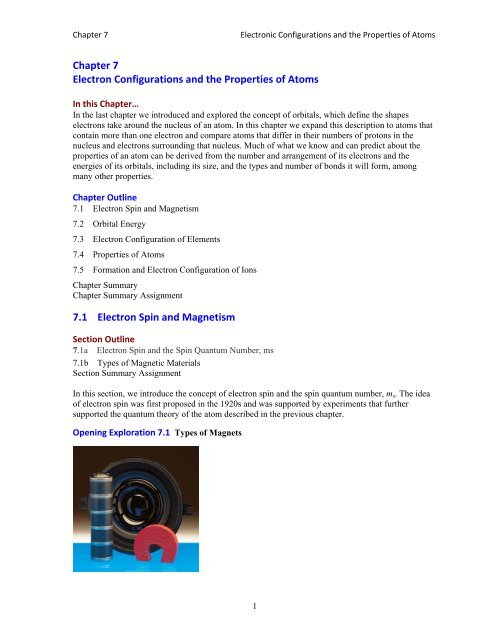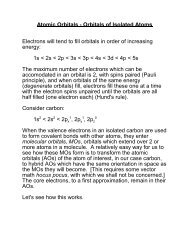Chapter 7 Electron Configurations and the Properties of Atoms 7.1 ...
Chapter 7 Electron Configurations and the Properties of Atoms 7.1 ...
Chapter 7 Electron Configurations and the Properties of Atoms 7.1 ...
Create successful ePaper yourself
Turn your PDF publications into a flip-book with our unique Google optimized e-Paper software.
<strong>Chapter</strong> 7 <strong>Electron</strong>ic <strong>Configurations</strong> <strong>and</strong> <strong>the</strong> <strong>Properties</strong> <strong>of</strong> <strong>Atoms</strong><br />
<strong>Chapter</strong> 7<br />
<strong>Electron</strong> <strong>Configurations</strong> <strong>and</strong> <strong>the</strong> <strong>Properties</strong> <strong>of</strong> <strong>Atoms</strong><br />
In this <strong>Chapter</strong>…<br />
In <strong>the</strong> last chapter we introduced <strong>and</strong> explored <strong>the</strong> concept <strong>of</strong> orbitals, which define <strong>the</strong> shapes<br />
electrons take around <strong>the</strong> nucleus <strong>of</strong> an atom. In this chapter we exp<strong>and</strong> this description to atoms that<br />
contain more than one electron <strong>and</strong> compare atoms that differ in <strong>the</strong>ir numbers <strong>of</strong> protons in <strong>the</strong><br />
nucleus <strong>and</strong> electrons surrounding that nucleus. Much <strong>of</strong> what we know <strong>and</strong> can predict about <strong>the</strong><br />
properties <strong>of</strong> an atom can be derived from <strong>the</strong> number <strong>and</strong> arrangement <strong>of</strong> its electrons <strong>and</strong> <strong>the</strong><br />
energies <strong>of</strong> its orbitals, including its size, <strong>and</strong> <strong>the</strong> types <strong>and</strong> number <strong>of</strong> bonds it will form, among<br />
many o<strong>the</strong>r properties.<br />
<strong>Chapter</strong> Outline<br />
<strong>7.1</strong> <strong>Electron</strong> Spin <strong>and</strong> Magnetism<br />
7.2 Orbital Energy<br />
7.3 <strong>Electron</strong> Configuration <strong>of</strong> Elements<br />
7.4 <strong>Properties</strong> <strong>of</strong> <strong>Atoms</strong><br />
7.5 Formation <strong>and</strong> <strong>Electron</strong> Configuration <strong>of</strong> Ions<br />
<strong>Chapter</strong> Summary<br />
<strong>Chapter</strong> Summary Assignment<br />
<strong>7.1</strong> <strong>Electron</strong> Spin <strong>and</strong> Magnetism<br />
Section Outline<br />
<strong>7.1</strong>a <strong>Electron</strong> Spin <strong>and</strong> <strong>the</strong> Spin Quantum Number, ms<br />
<strong>7.1</strong>b Types <strong>of</strong> Magnetic Materials<br />
Section Summary Assignment<br />
In this section, we introduce <strong>the</strong> concept <strong>of</strong> electron spin <strong>and</strong> <strong>the</strong> spin quantum number, ms. The idea<br />
<strong>of</strong> electron spin was first proposed in <strong>the</strong> 1920s <strong>and</strong> was supported by experiments that fur<strong>the</strong>r<br />
supported <strong>the</strong> quantum <strong>the</strong>ory <strong>of</strong> <strong>the</strong> atom described in <strong>the</strong> previous chapter.<br />
Opening Exploration <strong>7.1</strong> Types <strong>of</strong> Magnets<br />
1
<strong>Chapter</strong> 7 <strong>Electron</strong>ic <strong>Configurations</strong> <strong>and</strong> <strong>the</strong> <strong>Properties</strong> <strong>of</strong> <strong>Atoms</strong><br />
<strong>7.1</strong>a <strong>Electron</strong> Spin <strong>and</strong> <strong>the</strong> Spin Quantum Number, ms<br />
Although electrons are too small to observe directly, we can detect <strong>the</strong> magnetic field that <strong>the</strong>y exert.<br />
This magnetic field is generated by electron spin, <strong>the</strong> negatively charged electron spinning on an axis<br />
(Interactive Figure <strong>7.1</strong>.1).<br />
Interactive Figure <strong>7.1</strong>.1: Relate electron spin <strong>and</strong> magnetic properties.<br />
<strong>Electron</strong> spin <strong>and</strong> magnetic field<br />
The magnetic field produced by an electron occurs in one <strong>of</strong> two directions, indicating that electron<br />
spin is quantized. That is, an electron has only two possible spin states. In one spin state, <strong>the</strong> electron<br />
produces a magnetic field with <strong>the</strong> North pole in one direction. In <strong>the</strong> o<strong>the</strong>r spin state, <strong>the</strong> North pole<br />
is in <strong>the</strong> opposite direction (Figure <strong>7.1</strong>.2).<br />
Figure <strong>7.1</strong>.2 <strong>Electron</strong> spin <strong>and</strong> magnetic fields.<br />
Spin states are defined by a fourth quantum number, <strong>the</strong> spin quantum number, ms. Because <strong>the</strong>re<br />
are two different spin states, ms has two possible values: +½ or ½. The sign <strong>of</strong> ms is used to indicate<br />
<strong>the</strong> fact that <strong>the</strong> two spin states are in opposite directions <strong>and</strong> should not be confused with <strong>the</strong><br />
negative charge on <strong>the</strong> electron.<br />
Symbolizing <strong>Electron</strong> Spin We saw in <strong>the</strong> previous chapter that lines or boxes can be used to depict<br />
orbitals. <strong>Electron</strong>s in orbitals are shown using arrows, where <strong>the</strong> direction <strong>of</strong> <strong>the</strong> arrow indicates <strong>the</strong><br />
spin state <strong>of</strong> <strong>the</strong> electron. For example, in <strong>the</strong> diagram that follows, <strong>the</strong> upward () <strong>and</strong> downward ()<br />
arrows indicate electrons in different spin states.<br />
- 2 -
<strong>Chapter</strong> 7 <strong>Electron</strong>ic <strong>Configurations</strong> <strong>and</strong> <strong>the</strong> <strong>Properties</strong> <strong>of</strong> <strong>Atoms</strong><br />
In this text, we will arbitrarily assign ms = +½ to electrons represented with an upward arrow (also<br />
called “spin up” electrons) <strong>and</strong> ms = ½ to electrons represented with a downward arrow (also called<br />
“spin down” electrons).<br />
<strong>7.1</strong>b Types <strong>of</strong> Magnetic Materials<br />
Magnetic materials derive <strong>the</strong>ir magnetic behavior from <strong>the</strong> magnetic properties <strong>of</strong> <strong>the</strong>ir electrons.<br />
Because all electrons produce a magnetic field, you might ask <strong>the</strong> question, “Why aren’t all materials<br />
magnetic?” The answer lies in <strong>the</strong> fact that <strong>the</strong> magnetic fields generated by electrons with opposite<br />
spin (in a single atom, molecule, or ion) directly counteract <strong>and</strong> cancel each o<strong>the</strong>r. Therefore, any<br />
atom or molecule with half spin up electrons <strong>and</strong> half spin down electrons will have a net magnetic<br />
field <strong>of</strong> zero. Two electrons with opposite spin are said to be spin paired <strong>and</strong> produce no net magnetic<br />
field. An uneven number <strong>of</strong> electrons leaves unpaired electrons. Materials with unpaired electrons are<br />
magnetic.<br />
The magnetism <strong>of</strong> most materials can be categorized as being diamagnetic, paramagnetic, or<br />
ferromagnetic. In a diamagnetic material (Interactive Figure <strong>7.1</strong>.3(a)), all electrons are spin paired<br />
<strong>and</strong> <strong>the</strong> material does not have a net magnetic field. These materials are slightly repelled by <strong>the</strong><br />
magnetic field <strong>of</strong> a strong magnet.<br />
Interactive Figure <strong>7.1</strong>.3: Use spin states to predict magnetic properties.<br />
<strong>Electron</strong> spin representations <strong>of</strong> a material with (a) diamagnetic, (b) paramagnetic, <strong>and</strong> (c)<br />
ferromagnetic properties.<br />
Paramagnetic materials (Interactive Figure <strong>7.1</strong>.3(b)) contain atoms, molecules, or ions with<br />
unpaired electrons. In <strong>the</strong> absence <strong>of</strong> an external, strong magnetic field, <strong>the</strong> magnetic fields generated<br />
by <strong>the</strong> individual particles are arranged in r<strong>and</strong>om directions <strong>and</strong> <strong>the</strong> magnetism produced by each<br />
atom or molecule can be cancelled by <strong>the</strong> magnetic fields around it. This results in a magnetic<br />
material, but one with a weak net magnetic field. However, <strong>the</strong> presence <strong>of</strong> strong, external magnet<br />
causes <strong>the</strong> individual spins to align so that <strong>the</strong> material is attracted to <strong>the</strong> magnet.<br />
Ferromagnetic materials (Interactive Figure <strong>7.1</strong>.3(c)), like paramagnetic materials, contain<br />
particles with unpaired electrons. In <strong>the</strong>se materials, however, <strong>the</strong> individual magnetic fields align<br />
naturally <strong>and</strong> produce a strong, permanent magnetic field. The common magnets you are familiar<br />
with are ferromagnets.<br />
- 3 -
<strong>Chapter</strong> 7 <strong>Electron</strong>ic <strong>Configurations</strong> <strong>and</strong> <strong>the</strong> <strong>Properties</strong> <strong>of</strong> <strong>Atoms</strong><br />
7.2 Orbital Energy<br />
Section Outline<br />
7.2a Orbital Energies in Single- <strong>and</strong> Multielectron Species<br />
Section Summary Assignment<br />
In <strong>the</strong> previous chapter, we observed that <strong>the</strong> energy <strong>of</strong> an orbital in a hydrogen atom is related to its<br />
size: <strong>the</strong> larger <strong>the</strong> orbital, <strong>the</strong> higher <strong>the</strong> energy <strong>of</strong> an electron in that orbital. The size <strong>of</strong> <strong>the</strong> orbital<br />
was also shown to be dependent on <strong>the</strong> principal quantum number, n. In this section, we explore <strong>the</strong><br />
energy <strong>of</strong> orbitals in single- <strong>and</strong> multielectron atoms.<br />
Opening Exploration 7.2<br />
7.2 Orbital Energies in Single‐ <strong>and</strong> Multielectron Species<br />
The relationship between <strong>the</strong> principal quantum number, n, <strong>and</strong> orbital energy is shown in an orbital<br />
energy diagram (Figure 7.2.1).<br />
Figure 7.2.1 Identify Orbital Energies in Single-<strong>Electron</strong> Species<br />
Orbital energies (n = 1 to n = 4) in a single‐electron species<br />
For a single-electron species such as a hydrogen atom, <strong>the</strong> energy <strong>of</strong> <strong>the</strong> atomic orbitals depends<br />
only on <strong>the</strong> value <strong>of</strong> n. For example, a 2p orbital in a hydrogen atom has <strong>the</strong> same energy as a 2s<br />
orbital. The energy <strong>of</strong> an orbital in a single-electron system depends only on <strong>the</strong> degree <strong>of</strong> attraction<br />
- 4 -
<strong>Chapter</strong> 7 <strong>Electron</strong>ic <strong>Configurations</strong> <strong>and</strong> <strong>the</strong> <strong>Properties</strong> <strong>of</strong> <strong>Atoms</strong><br />
between <strong>the</strong> electron in that orbital <strong>and</strong> <strong>the</strong> nucleus. This is mainly a function <strong>of</strong> <strong>the</strong> average distance<br />
<strong>of</strong> <strong>the</strong> electron from <strong>the</strong> nucleus, which is controlled by <strong>the</strong> principal quantum number, n.<br />
In multielectron species such as helium atoms or sodium ions, <strong>the</strong> orbital energies depend both on<br />
<strong>the</strong> principal quantum number, n, <strong>and</strong> <strong>the</strong> type <strong>of</strong> orbital, given by <strong>the</strong> angular momentum quantum<br />
number, (Interactive Figure 7.2.2). Multielectron atoms are more complex because <strong>the</strong> energy <strong>of</strong><br />
<strong>the</strong> electron depends on both how close an electron is to <strong>the</strong> nucleus <strong>and</strong> <strong>the</strong> degree to which it<br />
experiences repulsive forces with <strong>the</strong> o<strong>the</strong>r electrons present in <strong>the</strong> atom or ion.<br />
Interactive Figure 7.2.2: Identify orbital energies in multi-electron species.<br />
Orbital energies in a multielectron species<br />
As shown in Interactive Figure 7.2.2, subshell energies increase with increasing (in a given energy<br />
level, s < p < d < f).<br />
Using Interactive Figure 7.2.2 as a reference, we can make several generalizations about orbital<br />
energies in multielectron species.<br />
As n increases, orbital energy increases for orbitals <strong>of</strong> <strong>the</strong> same type.<br />
A 4s orbital is higher in energy than a 3s orbital.<br />
As increases, orbital energy increases.<br />
In <strong>the</strong> n = 3 shell, 3s < 3p < 3d.<br />
As n increases, <strong>the</strong> subshell energies become more closely spaced <strong>and</strong> overlapping occurs.<br />
The 4f orbital is higher in energy than <strong>the</strong> 5s orbital, despite its lower n value.<br />
7.3 <strong>Electron</strong> Configuration <strong>of</strong> Elements<br />
Section Outline<br />
7.3a The Pauli Exclusion Principle<br />
7.3b <strong>Electron</strong> <strong>Configurations</strong> for Elements in Periods 1–3<br />
7.3c <strong>Electron</strong> <strong>Configurations</strong> for Elements in Periods 4–7<br />
7.3d <strong>Electron</strong> <strong>Configurations</strong> <strong>and</strong> <strong>the</strong> Periodic Table<br />
Section Summary Assignment<br />
The electron configuration <strong>of</strong> an element shows how electrons are distributed in orbitals—<br />
which ones are filled <strong>and</strong> which ones remain vacant. We can predict <strong>the</strong> electron configuration <strong>of</strong><br />
- 5 -
<strong>Chapter</strong> 7 <strong>Electron</strong>ic <strong>Configurations</strong> <strong>and</strong> <strong>the</strong> <strong>Properties</strong> <strong>of</strong> <strong>Atoms</strong><br />
most elements, <strong>and</strong> we can use electron configurations to predict physical <strong>and</strong> chemical properties <strong>of</strong><br />
<strong>the</strong> elements.<br />
Opening Exploration 7.3 <strong>Electron</strong> <strong>Configurations</strong><br />
7.3a The Pauli Exclusion Principle<br />
To predict <strong>the</strong> electron configuration for an atom’s ground state, <strong>the</strong> lowest energy state for an atom,<br />
electrons are put into <strong>the</strong> orbitals with <strong>the</strong> lowest energy possible, placing no more than two electrons<br />
in an orbital.<br />
The order <strong>of</strong> subshell filling is related to n, <strong>the</strong> principal quantum number, <strong>and</strong> , <strong>the</strong> angular<br />
momentum quantum number. In general,<br />
electrons fill orbitals in order <strong>of</strong> increasing (n + ) <strong>and</strong><br />
when two or more subshells have <strong>the</strong> same (n + ) value, electrons fill <strong>the</strong> orbital with <strong>the</strong><br />
lower n value.<br />
These general rules result in <strong>the</strong> following orbital filling order:<br />
1s, 2s, 2p, 3s, 3p, 4s, 3d, 4p, 5s, 4d, 5p, 6s, 4f, 5d, 6p, 7s, 5f, 6d, 7p, 8s, …<br />
The Pauli exclusion principle states that no two electrons within an atom can have <strong>the</strong> same set <strong>of</strong><br />
four quantum numbers (n, , ml, <strong>and</strong> ms). The limits on possible values for <strong>the</strong> four quantum numbers<br />
means that a single orbital can accommodate no more than two electrons, <strong>and</strong> when an orbital<br />
contains two electrons, those electrons must have opposite spins (Figure 7.3.1).<br />
Figure 7.3.1 Apply <strong>the</strong> Pauli Exclusion Principle<br />
<strong>Electron</strong> arrangements in an orbital that are (a) allowed <strong>and</strong> (b) not allowed<br />
- 6 -
<strong>Chapter</strong> 7 <strong>Electron</strong>ic <strong>Configurations</strong> <strong>and</strong> <strong>the</strong> <strong>Properties</strong> <strong>of</strong> <strong>Atoms</strong><br />
Quick Check<br />
Q1: Which orbital fills first, 4d or 5s?<br />
4d<br />
5s<br />
Q2: Is <strong>the</strong> following electron arrangement allowed or not allowed?<br />
allowed<br />
not allowed<br />
7.3b <strong>Electron</strong> <strong>Configurations</strong> for Elements in Periods 1–3<br />
Hydrogen <strong>and</strong> Helium Hydrogen has a single electron that occupies <strong>the</strong> orbital with <strong>the</strong> lowest<br />
energy, <strong>the</strong> 1s orbital. Two methods are used to represent this electron configuration. The spdf<br />
notation (also called spectroscopic notation) has <strong>the</strong> general format n # , where subshells are listed in<br />
<strong>the</strong> order in which <strong>the</strong>y are filled <strong>and</strong> <strong>the</strong> number <strong>of</strong> electrons occupying each subshell is shown to <strong>the</strong><br />
right <strong>of</strong> <strong>the</strong> subshell as a superscript. The spdf notation for hydrogen is<br />
H: 1s 1 (pronounced “one-ess-one”)<br />
Orbital box notation uses boxes or horizontal lines to represent orbitals <strong>and</strong> arrows to represent<br />
electrons. The electron configuration <strong>of</strong> hydrogen in orbital box notation is<br />
Helium has two electrons, <strong>and</strong> both occupy <strong>the</strong> lowest-energy 1s orbital. The electron configuration<br />
<strong>of</strong> helium in spdf notation <strong>and</strong> orbital box notation is <strong>the</strong>refore<br />
Each electron in helium has a unique set <strong>of</strong> four quantum numbers, as required by <strong>the</strong> Pauli exclusion<br />
principle. Notice that hydrogen <strong>and</strong> helium are in <strong>the</strong> first row <strong>of</strong> <strong>the</strong> periodic table <strong>and</strong> both elements<br />
fill orbitals in <strong>the</strong> first energy level (1s).<br />
Orbital box notations provide information about <strong>the</strong> number <strong>of</strong> paired <strong>and</strong> unpaired electrons in an<br />
atom, <strong>and</strong> that information can be used to determine whe<strong>the</strong>r <strong>the</strong> atoms are paramagnetic or<br />
diamagnetic. Hydrogen has one unpaired electron <strong>and</strong> is a paramagnetic species, whereas helium’s<br />
electrons are paired <strong>and</strong> it is diamagnetic.<br />
Lithium to Neon Lithium has three electrons, two in <strong>the</strong> 1s orbital <strong>and</strong> one that is in an orbital in<br />
<strong>the</strong> second energy level. As shown previously, <strong>the</strong> 2s orbital is lower in energy than <strong>the</strong> 2p orbitals, so<br />
<strong>the</strong> electron configuration <strong>of</strong> lithium in spdf notation <strong>and</strong> orbital box notation is<br />
Notice that it would be more correct to draw <strong>the</strong> orbital box notation electron configuration <strong>of</strong> lithium<br />
as shown below because <strong>the</strong> 2s orbital is higher in energy than <strong>the</strong> 1s orbital.<br />
- 7 -
<strong>Chapter</strong> 7 <strong>Electron</strong>ic <strong>Configurations</strong> <strong>and</strong> <strong>the</strong> <strong>Properties</strong> <strong>of</strong> <strong>Atoms</strong><br />
However, it is common to show all orbitals on a horizontal line when writing orbital box notation<br />
electron configurations in order to make more efficient use <strong>of</strong> space.<br />
Beryllium has two electrons in <strong>the</strong> 1s <strong>and</strong> <strong>the</strong> 2s orbitals.<br />
Boron has five electrons. Four electrons fill <strong>the</strong> 1s <strong>and</strong> 2s orbitals, <strong>and</strong> <strong>the</strong> fifth electron is in a 2p<br />
orbital. Notice that <strong>the</strong> orbital box diagram shows all three 2p orbitals even though only one <strong>of</strong> <strong>the</strong> 2p<br />
orbitals is occupied.<br />
Carbon has six electrons, four in <strong>the</strong> 1s <strong>and</strong> 2s orbitals <strong>and</strong> two in <strong>the</strong> 2p orbitals. When electrons<br />
occupy a subshell with multiple orbitals such as 2p, Hund’s rule <strong>of</strong> maximum multiplicity applies.<br />
This rule states that <strong>the</strong> lowest-energy electron configuration is <strong>the</strong> one where <strong>the</strong> maximum number<br />
<strong>of</strong> electrons is unpaired. In <strong>the</strong> case <strong>of</strong> carbon, this means that <strong>the</strong> two 2p electrons each occupy a<br />
different 2p orbital (Interactive Figure 7.3.2).<br />
Interactive Figure 7.3.2: Apply Hund’s rule <strong>of</strong> maximum multiplicity.<br />
Carbon’s electron configuration has two unpaired electrons in <strong>the</strong> 2p orbitals.<br />
The electron configurations <strong>of</strong> nitrogen, oxygen, fluorine, <strong>and</strong> neon are shown here. Notice that <strong>the</strong><br />
highest-energy orbital for all second-row elements is in <strong>the</strong> second energy level (2s or 2p).<br />
Sodium to Argon The elements in <strong>the</strong> third row <strong>of</strong> <strong>the</strong> periodic table have electrons that occupy<br />
orbitals in <strong>the</strong> third energy level, as shown.<br />
- 8 -
<strong>Chapter</strong> 7 <strong>Electron</strong>ic <strong>Configurations</strong> <strong>and</strong> <strong>the</strong> <strong>Properties</strong> <strong>of</strong> <strong>Atoms</strong><br />
When electron configurations for multielectron species are written, noble gas notation is <strong>of</strong>ten used<br />
to represent filled shells (<strong>the</strong>se filled shells are also called core electrons). In noble gas notation, <strong>the</strong><br />
symbol for a noble gas is written within square brackets in front <strong>of</strong> <strong>the</strong> spdf or orbital box notation<br />
representing additional, noncore electrons. For example, <strong>the</strong> electron configuration for chlorine is<br />
written using noble gas notation as shown here.<br />
The symbol [Ne] represents <strong>the</strong> 10 lowest-energy electrons (1s 2 2s 2 2p 6 ) in <strong>the</strong> electron configuration.<br />
EXAMPLE PROBLEM: Write electron configurations for period 1–3 elements.<br />
Write <strong>the</strong> electron configuration for phosphorus using orbital box notation.<br />
SOLUTION:<br />
You are asked to write <strong>the</strong> electron configuration for an element in orbital box notation.<br />
You are given <strong>the</strong> identity <strong>of</strong> <strong>the</strong> element.<br />
7.3.1T: Tutorial Assignment<br />
7.3.1: Mastery Assignment<br />
7.3c <strong>Electron</strong> <strong>Configurations</strong> for Elements in Periods 4–7<br />
Both potassium <strong>and</strong> calcium have electron configurations similar to those <strong>of</strong> o<strong>the</strong>r elements in Groups<br />
1A <strong>and</strong> 2A.<br />
Sc<strong>and</strong>ium is <strong>the</strong> first transition element, <strong>and</strong> it is <strong>the</strong> first element to fill <strong>the</strong> 3d orbitals. The electron<br />
configurations <strong>of</strong> <strong>the</strong> transition elements follow Hund’s rule:<br />
- 9 -
<strong>Chapter</strong> 7 <strong>Electron</strong>ic <strong>Configurations</strong> <strong>and</strong> <strong>the</strong> <strong>Properties</strong> <strong>of</strong> <strong>Atoms</strong><br />
Both chromium <strong>and</strong> copper have electron configurations that do not follow <strong>the</strong> general filling order,<br />
for reasons that are complex <strong>and</strong> related to <strong>the</strong> similar energies <strong>of</strong> <strong>the</strong> 4s <strong>and</strong> 3d orbitals in<br />
multielectron atoms. The electron configurations for <strong>the</strong>se elements should be memorized. The<br />
electron configurations for all elements are shown in Interactive Table 7.3.1. There are a few<br />
exceptions to <strong>the</strong> general filling order in <strong>the</strong> heavier elements, but most elements follow <strong>the</strong> general<br />
guidelines that we have used to write electron configurations.<br />
- 10 -
<strong>Chapter</strong> 7 <strong>Electron</strong>ic <strong>Configurations</strong> <strong>and</strong> <strong>the</strong> <strong>Properties</strong> <strong>of</strong> <strong>Atoms</strong><br />
Interactive Table 7.3.1 <strong>Electron</strong> <strong>Configurations</strong> <strong>of</strong> <strong>Atoms</strong> in <strong>the</strong> Ground State<br />
Z Element Configuration Z Element Configuration Z Element Configuration<br />
1 H 1s 1 41 Nb [Kr]5s 1 4d 4<br />
81 Tl [Xe]6s 2 5d 10 4f 14 6p 1<br />
2 He 1s 2 42 Mo [Kr]5s 1 4d 5<br />
82 Pb [Xe]6s 2 5d 10 4f 14 6p 2<br />
3 Li [He]2s 1 43 Tc [Kr]5s 2 4d 5<br />
83 Bi [Xe]6s 2 5d 10 4f 14 6p 3<br />
4 Be [He]2s 2 44 Ru [Kr]5s 1 4d 7<br />
84 Po [Xe]6s 2 5d 10 4f 14 6p 4<br />
5 B [He]2s 2 2p 1 45 Rh [Kr]5s 1 4d 8<br />
85 At [Xe]6s 2 5d 10 4f 14 6p 5<br />
6 C [He]2s 2 2p 2<br />
46 Pd [Kr] 4d 10<br />
86 Rn [Xe]6s 2 5d 10 4f 14 6p 6<br />
7 N [He]2s 2 2p 3<br />
47 Ag [Kr]5s 1 4d 10<br />
87 Fr [Rn]7s 1<br />
8 O [He]2s 2 2p 4<br />
48 Cd [Kr]5s 2 4d 10 88 Ra [Rn]7s 2<br />
9 F [He]2s 2 2p 5<br />
49 In [Kr]5s 2 4d 10 5p 1 89 Ac [Rn]7s 2 6d 1<br />
10 Ne [He]2s 2 2p 6 50 Sn [Kr]5s 2 4d 10 5p 2<br />
90 Th [Rn]7s 2 6d 2<br />
11 Na [Ne]3s 1 51 Sb [Kr]5s 2 4d 10 5p 3<br />
91 Pa [Rn]7s 2 6d 1 5f 2<br />
12 Mg [Ne]3s 2 52 Te [Kr]5s 2 4d 10 5p 4<br />
92 U [Rn]7s 2 6d 1 5f 3<br />
13 Al [Ne]3s 2 3p 1 53 I [Kr]5s 2 4d 10 5p 5<br />
93 Np [Rn]7s 2 6d 1 5f 4<br />
14 Si [Ne]3s 2 3p 2<br />
54 Xe [Kr]5s 2 4d 10 5p 6<br />
94 Pu [Rn]7s 2 5f 6<br />
15 P [Ne]3s 2 3p 3<br />
55 Cs [Xe]6s 1 95 Am [Rn]7s 2 5f 7<br />
16 S [Ne]3s 2 3p 4 56 Ba [Xe]6s 2 96 Cm [Rn]7s 2 6d 1 5f 7<br />
17 Cl [Ne]3s 2 3p 5<br />
57 La [Xe]6s 2 5d 1 97 Bk [Rn]7s 2 5f 9<br />
18 Ar [Ne]3s 2 3p 6 58 Ce [Xe]6s 2 5d 1 4f 1 98 Cf [Rn]7s 2 5f 10<br />
19 K [Ar]4s 1 59 Pr [Xe]6s 2 4f 3<br />
99 Es [Rn]7s 2 5f 11<br />
20 Ca [Ar]4s 2 60 Nd [Xe]6s 2 4f 4 100 Fm [Rn]7s 2 5f 12<br />
21 Sc [Ar]4s 2 3d 1 61 Pm [Xe]6s 2 4f 5<br />
101 Md [Rn]7s 2 5f 13<br />
22 Ti [Ar]4s 2 3d 2 62 Sm [Xe]6s 2 4f 6<br />
102 No [Rn]7s 2 5f 14<br />
23 V [Ar]4s 2 3d 3 63 Eu [Xe]6s 2 4f 7 103 Lr [Rn]7s 2 6d 1 5f 14<br />
24 Cr [Ar]4s 1 3d 5 64 Gd [Xe]6s 2 5d 1 4f 7 104 Rf [Rn]7s 2 6d 2 5f 14<br />
25 Mn [Ar]4s 2 3d 5 65 Tb [Xe]6s 2 4f 9 105 Db [Rn]7s 2 6d 3 5f 14<br />
26 Fe [Ar]4s 2 3d 6 66 Dy [Xe]6s 2 4f 10<br />
106 Sg [Rn]7s 2 6d 4 5f 14<br />
27 Co [Ar]4s 2 3d 7 67 Ho [Xe]6s 2 4f 11 107 Bh [Rn]7s 2 6d 5 5f 14<br />
28 Ni [Ar]4s 2 3d 8 68 Er [Xe]6s 2 4f 12 108 Hs [Rn]7s 2 6d 6 5f 14<br />
29 Cu [Ar]4s 1 3d 10 69 Tm [Xe]6s 2 4f 13 109 Mt [Rn]7s 2 6d 7 5f 14<br />
30 Zn [Ar]4s 2 3d 10 70 Yb [Xe]6s 2 4f 14 110 Ds [Rn]7s 2 6d 8 5f 14<br />
31 Ga [Ar]4s 2 3d 10 4p 1 71 Lu [Xe]6s 2 5d 1 4f 14 111 Rg [Rn]7s 2 6d 9 5f 14<br />
32 Ge [Ar]4s 2 3d 10 4p 2<br />
72 Hf [Xe]6s 2 5d 2 4f 14 112 Cn [Rn]7s 2 6d 10 5f 14<br />
33 As [Ar]4s 2 3d 10 4p 3<br />
73 Ta [Xe]6s 2 5d 3 4f 14 113 — [Rn]7s 2 6d 10 5f 14 7p 1<br />
34 Se [Ar]4s 2 3d 10 4p 4<br />
74 W [Xe]6s 2 5d 4 4f 14 114 — [Rn]7s 2 6d 10 5f 14 7p 2<br />
35 Br [Ar]4s 2 3d 10 4p 5<br />
75 Re [Xe]6s 2 5d 5 4f 14 115 — [Rn]7s 2 6d 10 5f 14 7p 3<br />
36 Kr [Ar]4s 2 3d 10 4p 6<br />
76 Os [Xe]6s 2 5d 6 4f 14 116 — [Rn]7s 2 6d 10 5f 14 7p 4<br />
37 Rb [Kr]5s 1 77 Ir [Xe]6s 2 5d 7 4f 14 117 — [Rn]7s 2 6d 10 5f 14 7p 5<br />
38 Sr [Kr]5s 2 78 Pt [Xe]6s 1 5d 9 4f 14 118 — [Rn]7s 2 6d 10 5f 14 7p 6<br />
39 Y [Kr]5s 2 4d 1 79 Au [Xe]6s 1 5d 10 4f 14<br />
40 Zr [Kr]5s 2 4d 2<br />
80 Hg [Xe]6s 2 5d 10 4f 14<br />
EXAMPLE PROBLEM: Write electron configurations for period 4–7 elements.<br />
Write electron configurations for <strong>the</strong> following elements, in spdf notation <strong>and</strong> orbital box notation.<br />
Identify <strong>the</strong> element as paramagnetic or diamagnetic.<br />
(a) Zn (Do not use <strong>the</strong> noble gas notation.)<br />
- 11 -
<strong>Chapter</strong> 7 <strong>Electron</strong>ic <strong>Configurations</strong> <strong>and</strong> <strong>the</strong> <strong>Properties</strong> <strong>of</strong> <strong>Atoms</strong><br />
(b) Sm (Use <strong>the</strong> noble gas notation.)<br />
SOLUTION:<br />
You are asked to write electron configurations in both spdf <strong>and</strong> orbital box notation <strong>and</strong> to identify<br />
<strong>the</strong> element as paramagnetic or diamagnetic.<br />
You are given <strong>the</strong> identity <strong>of</strong> <strong>the</strong> element.<br />
(a) Zinc is element 30. Use <strong>the</strong> filling order to write <strong>the</strong> electron configuration, keeping in mind <strong>the</strong><br />
maximum number <strong>of</strong> electrons that can be accommodated in a subshell.<br />
spdf notation: 1s 2 2s 2 2p 6 3s 2 3p 6 4s 2 3d 10<br />
orbital box notation:<br />
1s<br />
2s 2p 3s 3p 4s 3d<br />
Zinc is diamagnetic because its electron configuration shows no unpaired electrons.<br />
(b) Samarium is element 62. Use <strong>the</strong> symbol [Xe] to represent <strong>the</strong> first 54 electrons in <strong>the</strong> electron<br />
configuration.<br />
spdf notation: [Xe]6s 2 4f 6<br />
< Samarium is paramagnetic because its electron configuration shows six unpaired electrons.<br />
7.3.2T: Tutorial Assignment<br />
7.3.2: Mastery Assignment<br />
7.3d <strong>Electron</strong> <strong>Configurations</strong> <strong>and</strong> <strong>the</strong> Periodic Table<br />
Interactive Figure 7.3.3 shows <strong>the</strong> electron configurations for <strong>the</strong> elements in periods 1–3, written<br />
using spdf notation <strong>and</strong> noble gas notation.<br />
Interactive Figure 7.3.3: Relate electron configuration <strong>and</strong> <strong>the</strong> periodic table.<br />
<strong>Electron</strong> configurations, periods 1–3<br />
Notice that elements within a group have <strong>the</strong> following in common:<br />
They have <strong>the</strong> same number <strong>of</strong> electrons beyond <strong>the</strong> core electrons (represented by noble gas<br />
notation) <strong>and</strong> similar electron configurations. For example, both Li <strong>and</strong> Na have one electron<br />
- 12 -
<strong>Chapter</strong> 7 <strong>Electron</strong>ic <strong>Configurations</strong> <strong>and</strong> <strong>the</strong> <strong>Properties</strong> <strong>of</strong> <strong>Atoms</strong><br />
in addition to <strong>the</strong> core electrons, <strong>and</strong> both elements have <strong>the</strong> general electron configuration<br />
[noble gas]ns 1 .<br />
The number <strong>of</strong> electrons beyond <strong>the</strong> core electrons is equal to <strong>the</strong> group number (with <strong>the</strong><br />
exception <strong>of</strong> He).<br />
The electrons beyond <strong>the</strong> core electrons are <strong>the</strong> valence electrons for an element. The valence<br />
electrons are <strong>the</strong> highest-energy electrons <strong>and</strong> are <strong>the</strong> electrons least strongly attracted to <strong>the</strong> nucleus.<br />
It is <strong>the</strong>se electrons that are involved in chemical reactions <strong>and</strong> <strong>the</strong> formation <strong>of</strong> chemical bonds. As<br />
shown in Interactive Figure 7.3.3 for <strong>the</strong> Group A elements, <strong>the</strong> number <strong>of</strong> valence electrons is<br />
equal to <strong>the</strong> group number <strong>of</strong> <strong>the</strong> element. The fact that elements within a group have similar electron<br />
configurations <strong>and</strong> <strong>the</strong> same number <strong>of</strong> valence electrons suggests that elements within a group have<br />
similar properties, something we will investigate later in this chapter.<br />
The orbital filling order is related to <strong>the</strong> structure <strong>of</strong> <strong>the</strong> periodic table, as shown in Interactive<br />
Figure 7.3.4.<br />
Interactive Figure 7.3.4: Identify electron configuration <strong>and</strong> valence electrons for element<br />
using <strong>the</strong> periodic table.<br />
Subshells <strong>and</strong> <strong>the</strong> periodic table<br />
The periodic table can be divided into four blocks, indicated by color in Interactive Figure 7.3.4,<br />
each <strong>of</strong> which represents <strong>the</strong> type <strong>of</strong> subshell that is filled with <strong>the</strong> highest-energy electrons for <strong>the</strong><br />
elements in that block. Elements in Groups 1A <strong>and</strong> 2A constitute <strong>the</strong> ns-block because <strong>the</strong> highestenergy<br />
electron is assigned to <strong>the</strong> ns orbital. Groups 3A through 8A make up <strong>the</strong> np-block, where np<br />
subshells are filled last. The s-block <strong>and</strong> p-block elements are <strong>the</strong> Group A elements in <strong>the</strong> periodic<br />
table <strong>and</strong> are commonly called <strong>the</strong> main-group elements. The transition elements sit within <strong>the</strong><br />
(n 1)d-block, <strong>and</strong> <strong>the</strong> lanthanide <strong>and</strong> actinide elements make up <strong>the</strong> (n 2)f-block.<br />
The number <strong>of</strong> elements in each horizontal row within a block is related to <strong>the</strong> number <strong>of</strong> orbitals<br />
within that block <strong>and</strong> <strong>the</strong> number <strong>of</strong> electrons that can fill that subshell. For example, <strong>the</strong> d-block is<br />
10 elements across because <strong>the</strong> d subshell contains five d orbitals <strong>and</strong> can accommodate a maximum<br />
<strong>of</strong> 10 electrons.<br />
The periodic table can be used to generate electron configurations by “counting up” from hydrogen<br />
to <strong>the</strong> desired element. Each element represents <strong>the</strong> addition <strong>of</strong> one electron to an orbital. For<br />
- 13 -
<strong>Chapter</strong> 7 <strong>Electron</strong>ic <strong>Configurations</strong> <strong>and</strong> <strong>the</strong> <strong>Properties</strong> <strong>of</strong> <strong>Atoms</strong><br />
example, arsenic, As, is a p-block element. To “count up” to As, you begin with <strong>the</strong> first-row<br />
elements, H <strong>and</strong> He, each <strong>of</strong> which represents an electron in <strong>the</strong> 1s orbital (1s 2 ). Next, Li <strong>and</strong> Be<br />
represent 2s 2 <strong>and</strong> B through Ne represent 2p 6 . Similarly, Na <strong>and</strong> Mg represent 3s 2 <strong>and</strong> Al through Ar<br />
represent 3p 6 . In <strong>the</strong> fourth row <strong>of</strong> <strong>the</strong> periodic table, K <strong>and</strong> Ca represent 4s 2 , Sc through Zn represent<br />
3d 10 , <strong>and</strong> Ga through As represent three electrons in <strong>the</strong> 4p orbital, 4p 3 . The electron configuration <strong>of</strong><br />
arsenic is<br />
As: 1s 2 2s 2 2p 6 3s 2 3p 6 4s 2 3d 10 4p 3 [Ar]4s 2 3d 10 4p 3<br />
7.4 <strong>Properties</strong> <strong>of</strong> <strong>Atoms</strong><br />
Section Outline<br />
7.4a Trends in Orbital Energies<br />
7.4b Atomic Size<br />
7.4c Ionization Energy<br />
7.4d <strong>Electron</strong> Affinity<br />
Section Summary Assignment<br />
<strong>Electron</strong> configurations play a large role in determining <strong>the</strong> properties <strong>of</strong> atoms. Some <strong>of</strong> <strong>the</strong> key<br />
factors that influence atomic properties include <strong>the</strong> size <strong>of</strong> <strong>the</strong> largest occupied orbitals, <strong>the</strong> energy <strong>of</strong><br />
<strong>the</strong> highest-energy orbitals, <strong>the</strong> number <strong>of</strong> orbital vacancies, <strong>and</strong> <strong>the</strong> number <strong>of</strong> electrons in <strong>the</strong><br />
highest-energy orbitals. Most atomic properties can be related to <strong>the</strong> degree <strong>of</strong> attraction between <strong>the</strong><br />
outermost electrons to <strong>the</strong> nucleus, <strong>and</strong> <strong>the</strong> number <strong>of</strong> electrons in <strong>the</strong> outermost electron shell, <strong>the</strong><br />
number <strong>of</strong> valence electrons.<br />
Opening Exploration 7.4 Orbital Energies <strong>and</strong> Atomic <strong>Properties</strong><br />
7.4a Trends in Orbital Energies<br />
As shown in <strong>the</strong> previous section, <strong>the</strong> organization <strong>of</strong> <strong>the</strong> periodic table is closely related to electron<br />
configurations. The energy <strong>of</strong> atomic orbitals is also related to <strong>the</strong> structure <strong>of</strong> <strong>the</strong> periodic table.<br />
As you move down within a group, <strong>the</strong> energy <strong>of</strong> highest-energy occupied orbitals increases.<br />
Likewise, <strong>the</strong> elements have greater numbers <strong>of</strong> electrons, <strong>and</strong> <strong>the</strong>y occupy orbitals with higher n. As<br />
<strong>the</strong> value <strong>of</strong> n increases from element to element, <strong>the</strong> orbitals are larger, <strong>the</strong> electrons in <strong>the</strong>se orbitals<br />
- 14 -
<strong>Chapter</strong> 7 <strong>Electron</strong>ic <strong>Configurations</strong> <strong>and</strong> <strong>the</strong> <strong>Properties</strong> <strong>of</strong> <strong>Atoms</strong><br />
are far<strong>the</strong>r from <strong>the</strong> nucleus, <strong>and</strong> <strong>the</strong> electrons in <strong>the</strong>se high-energy orbitals experience weaker<br />
electron–nucleus attractions.<br />
Similarly, as you move left to right across <strong>the</strong> periodic table within a period, <strong>the</strong> energy <strong>of</strong> all<br />
atomic orbitals <strong>of</strong> <strong>the</strong> elements decreases. Consider <strong>the</strong> elements in <strong>the</strong> third period, Na through Ar,<br />
for example (Interactive Figure 7.4.1).<br />
Interactive Figure 7.4.1: Explore orbital energies.<br />
Orbital energies, Na–Ar<br />
When moving from Na to Mg, two factors affect <strong>the</strong> energy <strong>of</strong> <strong>the</strong> atomic orbitals. First, <strong>the</strong> Mg<br />
nucleus has one more proton than <strong>the</strong> Na nucleus, which increases <strong>the</strong> nucleus–electron attractive<br />
forces. This will lower <strong>the</strong> energy <strong>of</strong> atomic orbitals. Second, Mg has one more electron than Na,<br />
which increases <strong>the</strong> electron–electron repulsions. This will increase <strong>the</strong> energy <strong>of</strong> atomic orbitals.<br />
As shown in Interactive Figure 7.4.1, <strong>the</strong> Mg atomic orbitals are lower in energy than <strong>the</strong> Na<br />
atomic orbitals. This suggests that <strong>the</strong> attractive forces that result from additional protons in <strong>the</strong><br />
nucleus are more important than <strong>the</strong> repulsive forces from <strong>the</strong> additional electrons. In general, when<br />
moving across a period from left to right, <strong>the</strong> attractive forces between <strong>the</strong> electrons <strong>and</strong> <strong>the</strong> nucleus<br />
increase <strong>and</strong> thus <strong>the</strong> orbital energies decrease.<br />
Figure 7.4.2 Relative Orbital Energy <strong>of</strong> <strong>the</strong> Elements<br />
- 15 -
<strong>Chapter</strong> 7 <strong>Electron</strong>ic <strong>Configurations</strong> <strong>and</strong> <strong>the</strong> <strong>Properties</strong> <strong>of</strong> <strong>Atoms</strong><br />
Effective Nuclear Charge The combination <strong>of</strong> attractive forces between electrons <strong>and</strong> <strong>the</strong> nucleus <strong>and</strong><br />
electron–electron repulsive forces is called <strong>the</strong> effective nuclear charge <strong>and</strong> is given <strong>the</strong> symbol Z*.<br />
The effective nuclear charge for <strong>the</strong> highest-energy electrons in an atom is <strong>the</strong> nuclear charge felt by<br />
those electrons, taking into account <strong>the</strong> electron–electron repulsive forces between high-energy<br />
electrons <strong>and</strong> core electrons. A simplified method for calculating Z* for <strong>the</strong> highest-energy electrons<br />
in an atom is<br />
Z* = Z [number <strong>of</strong> core electrons]<br />
Using this simplified method, we can calculate values <strong>of</strong> Z <strong>and</strong> Z* for Na through Ar:<br />
Na Mg Al Si P S Cl Ar<br />
Z 11 12 13 14 15 16 17 18<br />
Z* 1 2 3 4 5 6 7 8<br />
As Z* increases, <strong>the</strong> electrons feel a strong attractive force from <strong>the</strong> nucleus. This has <strong>the</strong> effect <strong>of</strong><br />
decreasing <strong>the</strong> energy <strong>of</strong> <strong>the</strong> atomic orbitals. As <strong>the</strong> energy <strong>of</strong> <strong>the</strong> atomic orbitals decreases, <strong>the</strong><br />
electrons are held closer to <strong>the</strong> nucleus <strong>and</strong> are held more tightly to <strong>the</strong> nucleus<br />
Interactive Figure 7.4.3: Explore effective nuclear charge.<br />
[<br />
Relative effective nuclear charge for <strong>the</strong> elements<br />
This general trend in orbital energies controls most <strong>of</strong> <strong>the</strong> observed trends we see in atomic<br />
properties, as we will explore in <strong>the</strong> rest <strong>of</strong> this chapter.<br />
7.4b Atomic Size<br />
The size <strong>of</strong> an atom is controlled by <strong>the</strong> size <strong>of</strong> its orbitals, but orbitals are boundless, with no defined<br />
outer limit. Chemists use many different definitions for <strong>the</strong> size <strong>of</strong> an atom. The covalent radius <strong>of</strong><br />
an element is <strong>the</strong> distance between <strong>the</strong> nuclei <strong>of</strong> two atoms <strong>of</strong> that element when <strong>the</strong>y are held<br />
toge<strong>the</strong>r by a single bond. For example, <strong>the</strong> distance between two bonded Cl atoms in Cl2 is 198 pm<br />
(Figure 7.4.4). Therefore, <strong>the</strong> covalent radius <strong>of</strong> each Cl atom is 99.0 pm. O<strong>the</strong>r covalent radii are<br />
determined from atom distances in molecules. Because distances between bonded atoms vary from<br />
molecule to molecule, tables <strong>of</strong> covalent radii show average values.<br />
Figure 7.4.4 The Distance Between Two Cl <strong>Atoms</strong> in Cl2 is 198 pm<br />
- 16 -
<strong>Chapter</strong> 7 <strong>Electron</strong>ic <strong>Configurations</strong> <strong>and</strong> <strong>the</strong> <strong>Properties</strong> <strong>of</strong> <strong>Atoms</strong><br />
The metallic radius <strong>of</strong> an element is <strong>the</strong> distance between <strong>the</strong> nuclei <strong>of</strong> two atoms in a metallic<br />
crystal. Tables <strong>of</strong> atomic radii generally report covalent radii for nonmetals <strong>and</strong> metallic radii for<br />
metals.<br />
The size <strong>of</strong> an atom is closely related to its electron configuration. Recall that <strong>the</strong> lower an orbital’s<br />
energy, <strong>the</strong> more tightly an electron in that orbital is held to <strong>the</strong> nucleus <strong>and</strong> <strong>the</strong> smaller <strong>the</strong> orbital.<br />
Therefore, <strong>the</strong> trend in atomic size follows that <strong>of</strong> orbital energies, with <strong>the</strong> smallest atoms in <strong>the</strong> top<br />
right <strong>of</strong> <strong>the</strong> periodic table <strong>and</strong> <strong>the</strong> largest atoms in <strong>the</strong> lower left (Interactive Figure 7.4.5).<br />
Interactive Figure 7.4.5: Explore atomic size <strong>of</strong> <strong>the</strong> elements.<br />
Atom radii (pm)<br />
7.4c Ionization Energy<br />
Ionization energy is <strong>the</strong> amount <strong>of</strong> energy required to remove an electron from a gaseous atom.<br />
X(g) X + (g) + e (g) E = ionization energy<br />
All atoms require energy to remove an electron, <strong>and</strong> <strong>the</strong>refore ionization energy values are positive.<br />
The trends in ionization energies follow that expected based on orbital energies (Interactive Figure<br />
7.4.6).<br />
- 17 -
<strong>Chapter</strong> 7 <strong>Electron</strong>ic <strong>Configurations</strong> <strong>and</strong> <strong>the</strong> <strong>Properties</strong> <strong>of</strong> <strong>Atoms</strong><br />
Interactive Figure 7.4.6: Explore ionization energy values.<br />
Ionization energy values for elements in periods 1–3<br />
Notice that <strong>the</strong> elements far<strong>the</strong>r down within a group, for example, moving from H to Li to Na, have<br />
decreased ionization energy. This trend is related to orbital energies. The electron removed from<br />
sodium occupies a 3s orbital, which is higher in energy than <strong>the</strong> electron lost by lithium (2s), which in<br />
turn is higher than <strong>the</strong> energy <strong>of</strong> <strong>the</strong> electron lost by hydrogen (1s).<br />
Ionization energy generally increases when moving left to right across a period. This trend is<br />
related both to orbital energies <strong>and</strong> to effective nuclear charge, Z*. Orbital energies decrease <strong>and</strong> Z*<br />
increases in <strong>the</strong> elements as you move left to right across a period. Therefore, <strong>the</strong> far<strong>the</strong>r right an<br />
element is, <strong>the</strong> more strongly <strong>the</strong> outermost electrons are attracted to <strong>the</strong> nucleus <strong>and</strong> <strong>the</strong> higher <strong>the</strong><br />
ionization energies are, in general, a large, positive ionization energy value indicates that an element<br />
is more stable as a neutral atom than as a cation.<br />
Notice that Interactive Figure 7.4.4 shows two areas where <strong>the</strong>re are exceptions to <strong>the</strong> general trend<br />
in ionization energy values: at <strong>the</strong> Group 3A elements <strong>and</strong> at <strong>the</strong> Group 6A elements. In both cases,<br />
elements have ionization energy values that are lower than would be predicted based on <strong>the</strong> general<br />
trend.<br />
The lower-than-expected ionization energy values for <strong>the</strong> Group 3A elements can be explained by<br />
examining electron configurations <strong>of</strong> <strong>the</strong> Group 2A <strong>and</strong> 3A elements.<br />
Group 2A: [noble gas]ns 2 Group 3A: [noble gas]ns 2 np 1<br />
The np electron removed from a Group 3A element has higher energy than <strong>the</strong> ns electron removed<br />
from a Group 2A element. The np electron is easier to remove than <strong>the</strong> ns electron, resulting in<br />
ionization energies for <strong>the</strong> Group 3A elements that are lower than predicted.<br />
The lower-than-expected ionization energy values for <strong>the</strong> Group 6A elements can be explained by<br />
examining electron configurations <strong>of</strong> <strong>the</strong> Group 5A <strong>and</strong> 6A elements.<br />
- 18 -
<strong>Chapter</strong> 7 <strong>Electron</strong>ic <strong>Configurations</strong> <strong>and</strong> <strong>the</strong> <strong>Properties</strong> <strong>of</strong> <strong>Atoms</strong><br />
The electron removed from a Group 6A element is in a filled np orbital. <strong>Electron</strong>–electron repulsive<br />
forces make it easier to remove this paired electron than <strong>the</strong> unpaired np electron removed from a<br />
Group 5A element; <strong>the</strong>refore, Group 6A elements have ionization energies that are lower than<br />
predicted.<br />
7.4d <strong>Electron</strong> Affinity<br />
<strong>Electron</strong> affinity is <strong>the</strong> energy change when a gaseous atom gains an electron.<br />
X(g) + e (g) X (g) E = electron affinity<br />
Although most elements have negative electron affinity values, some are slightly positive or close to<br />
zero. Keep in mind that a negative electron affinity value indicates that energy is released when an<br />
electron is added to a gaseous atom <strong>and</strong> that a large, negative electron affinity value indicates that an<br />
element is more stable as an anion than as a neutral atom. Not all atoms have a measurable electron<br />
affinity. Despite this, <strong>the</strong> trends in electron affinities generally follow those <strong>of</strong> <strong>the</strong> o<strong>the</strong>r periodic<br />
properties we have examined thus far (with numerous exceptions) (Interactive Figure 7.4.7).<br />
Interactive Figure 7.4.7: Explore electron affinity values.<br />
<strong>Electron</strong> affinity values for elements in periods 1–3<br />
Elements lower in a group generally have less negative electron affinity values than those higher in a<br />
group.<br />
H: 72.8 kJ/mol Li: 59.6 kJ/mol Na: 52.9 kJ/mol K: 48.4 kJ/mol<br />
As atomic size increases down a group, <strong>the</strong> orbital that is occupied by <strong>the</strong> new electron increases in<br />
energy. As <strong>the</strong> orbital energy increases, <strong>the</strong> attractive forces between <strong>the</strong> new electron <strong>and</strong> <strong>the</strong> nucleus<br />
decrease, so electron affinity becomes less negative. In general, adding electrons becomes less<br />
favorable <strong>the</strong> far<strong>the</strong>r down a group <strong>the</strong> element is.<br />
- 19 -
<strong>Chapter</strong> 7 <strong>Electron</strong>ic <strong>Configurations</strong> <strong>and</strong> <strong>the</strong> <strong>Properties</strong> <strong>of</strong> <strong>Atoms</strong><br />
<strong>Electron</strong> affinity values generally are more negative in elements far<strong>the</strong>r to <strong>the</strong> right across a period.<br />
There are some notable exceptions, however, at <strong>the</strong> Group 2A <strong>and</strong> 5A elements.<br />
The Group 2A elements have electron affinities that are very close to zero because <strong>the</strong> added<br />
electron occupies <strong>the</strong> np orbital. Adding an electron to this higher-energy orbital requires energy, so<br />
<strong>the</strong> electron affinity is much lower (less negative) than predicted from general trends. The Group 5A<br />
elements have low (less negative) electron affinity values because <strong>the</strong> added electron occupies a halffilled<br />
np orbital <strong>and</strong> introduces new electron–electron repulsion forces.<br />
Notice that <strong>the</strong> Group 8A elements also have electron affinity values that are close to zero. An<br />
electron added to a noble gas element would occupy <strong>the</strong> (n + 1)s orbital in a higher-energy level.<br />
Thus, <strong>the</strong> noble gases generally do not form anions.<br />
7.5 Formation <strong>and</strong> <strong>Electron</strong> Configuration <strong>of</strong> Ions<br />
Section Outline<br />
7.5a Cations<br />
7.5b Anions<br />
7.5c Ion Size<br />
Section Summary Assignment<br />
As you saw in <strong>Chapter</strong> 2, ions form when atoms gain or lose electrons. Whe<strong>the</strong>r an atom gains or<br />
loses electrons is related to orbital energy <strong>and</strong> atomic electron configuration. Recall from Section 7.4<br />
<strong>and</strong> Interactive Figure 7.4.x that <strong>the</strong> energy <strong>of</strong> <strong>the</strong> highest-energy occupied orbitals increases in each<br />
element as you move down within a group <strong>and</strong> <strong>the</strong> energy <strong>of</strong> all atomic orbitals decreases in each<br />
element as you move left to right across <strong>the</strong> periodic table.<br />
Opening Exploration 7.5 <strong>Electron</strong> <strong>Configurations</strong> <strong>of</strong> Ions<br />
- 20 -
<strong>Chapter</strong> 7 <strong>Electron</strong>ic <strong>Configurations</strong> <strong>and</strong> <strong>the</strong> <strong>Properties</strong> <strong>of</strong> <strong>Atoms</strong><br />
7.5a Cations<br />
A cation forms when an atom loses one or more electrons. Metals have low ionization energy values,<br />
so metals generally form cations. For example, sodium, a Group 1A element, loses one electron to<br />
form <strong>the</strong> sodium cation, Na + . Examination <strong>of</strong> <strong>the</strong> Na electron configuration shows that <strong>the</strong> highestenergy<br />
electron occupies <strong>the</strong> 3s orbital. This is <strong>the</strong> sodium valence electron, <strong>and</strong> it is this electron that<br />
is lost upon formation <strong>of</strong> Na + .<br />
The energy required to remove a second electron from an atom is <strong>the</strong> second ionization energy, IE2.<br />
For any atom, IE2 > IE1. Sodium does not normally form a +2 cation because <strong>the</strong> second electron is<br />
removed from <strong>the</strong> 2p subshell, which is much lower in energy than <strong>the</strong> 3s subshell. Removing an<br />
electron from an inner energy shell requires a great deal <strong>of</strong> energy, in this case almost 10 times as<br />
much as is required to remove <strong>the</strong> 3s valence electron.<br />
Magnesium, a Group 2A element, loses both <strong>of</strong> its valence electrons to form a +2 cation.<br />
- 21 -
<strong>Chapter</strong> 7 <strong>Electron</strong>ic <strong>Configurations</strong> <strong>and</strong> <strong>the</strong> <strong>Properties</strong> <strong>of</strong> <strong>Atoms</strong><br />
Like sodium, magnesium is expected to easily lose its valence electrons, but not an electron from a<br />
lower-energy shell. As shown in Table 7.5.1, <strong>the</strong> first <strong>and</strong> second ionization energies for Mg are<br />
relatively low, but <strong>the</strong> third ionization energy (IE3) is more than 10 times greater than IE1.<br />
Table 7.5.1 First, Second, <strong>and</strong> Third IE values for Mg<br />
Mg(g) Mg + (g) + e IE1 = 738 kJ/mol<br />
Mg 2 (g) Mg 2+ (g) + e IE2 = 1451 kJ/mol<br />
Mg 2+ (g) Mg 3+ (g) + e IE3 = 7733 kJ/mol<br />
In general, when metals form cations, <strong>the</strong>y lose electrons from <strong>the</strong> highest-energy occupied orbitals,<br />
those with <strong>the</strong> highest n value. Transition metals have valence electrons in ns, (n 1)d, <strong>and</strong> in <strong>the</strong><br />
case <strong>of</strong> lanthanides <strong>and</strong> actinides, (n 2)f orbitals. When a transition metal forms a cation, electrons<br />
are first lost from <strong>the</strong> outermost occupied orbital (<strong>the</strong> orbital with highest n). For example, when iron<br />
forms a +2 cation, it loses two 4s electrons.<br />
Recall that <strong>the</strong> 4s orbital is filled before <strong>the</strong> 3d orbitals are filled. However, electrons are removed<br />
from <strong>the</strong> highest-energy orbitals because those electrons feel <strong>the</strong> weakest attractive “pull” from <strong>the</strong><br />
positively charged nucleus.<br />
Transition metals <strong>of</strong>ten form more than one cation. Iron is commonly found in both <strong>the</strong> 2+ <strong>and</strong> 3+<br />
oxidation states. In <strong>the</strong> formation <strong>of</strong> Fe 3+ , two 4s electrons <strong>and</strong> one 3d electron are lost.<br />
- 22 -
<strong>Chapter</strong> 7 <strong>Electron</strong>ic <strong>Configurations</strong> <strong>and</strong> <strong>the</strong> <strong>Properties</strong> <strong>of</strong> <strong>Atoms</strong><br />
Notice that <strong>the</strong> electron removed to form Fe 3+ from Fe 2+ is taken from a filled 3d orbital, not a halffilled<br />
orbital. This minimizes <strong>the</strong> repulsive forces between electrons.<br />
EXAMPLE PROBLEM: Write electron configurations for cations.<br />
Write electron configurations for <strong>the</strong> following ions in spdf <strong>and</strong> orbital box notation.<br />
(a) Al 3+ (Do not use noble gas notation.)<br />
(b) Cr 2+ (Use noble gas notation.)<br />
SOLUTION:<br />
You are asked to write an electron configuration for a cation using spdf <strong>and</strong> orbital box notation.<br />
You are given <strong>the</strong> identity <strong>of</strong> <strong>the</strong> cation.<br />
(a) Aluminum is element 13. The element loses three electrons from its highest-energy orbitals to<br />
form <strong>the</strong> Al 3+ ion.<br />
(b) Chromium is element 24. The element loses two electrons from its highest-energy orbitals to<br />
form <strong>the</strong> Cr 2+ ion.<br />
Cr2 : [Ar]3d4 [Ar]<br />
4s 3d<br />
7.5.1T: Tutorial Assignment<br />
7.5.1: Mastery Assignment<br />
7.5b Anions<br />
An anion forms when an atom gains one or more electrons. Nonmetals have relatively large, negative<br />
electron affinity values, so nonmetals generally form anions. For example, chlorine gains one electron<br />
to form <strong>the</strong> chloride ion, Cl . Examination <strong>of</strong> <strong>the</strong> Cl electron configuration shows that <strong>the</strong> 3p subshell<br />
in Cl contains a single vacancy. Cl <strong>the</strong>refore gains a single electron in a 3p orbital to form Cl .<br />
- 23 -
<strong>Chapter</strong> 7 <strong>Electron</strong>ic <strong>Configurations</strong> <strong>and</strong> <strong>the</strong> <strong>Properties</strong> <strong>of</strong> <strong>Atoms</strong><br />
Sulfur has two 3p orbital vacancies <strong>and</strong> can <strong>the</strong>refore gain two electrons.<br />
The total number <strong>of</strong> electrons gained when an element forms an anion is related to <strong>the</strong> electron<br />
configuration <strong>of</strong> <strong>the</strong> element. In <strong>the</strong> case <strong>of</strong> Cl, only one electron is gained because a second electron<br />
would occupy <strong>the</strong> higher-energy 4s orbital. An electron in this orbital is far<strong>the</strong>r from <strong>the</strong> nucleus <strong>and</strong><br />
<strong>the</strong>refore feels less attractive “pull” from <strong>the</strong> nucleus. For <strong>the</strong> same reason, sulfur is <strong>of</strong>ten found as a<br />
2 anion <strong>and</strong> not a 3 anion.<br />
Finally, not all main-group elements commonly form ions. The Group 1A, 2A, <strong>and</strong> 3A metals lose<br />
lone, two, <strong>and</strong> three electrons, respectively, to form cations where <strong>the</strong> charge on <strong>the</strong> cation is equal to<br />
<strong>the</strong> group number. The Group 5A, 6A, <strong>and</strong> 7A nonmetals gain three, two, <strong>and</strong> one electrons,<br />
respectively, to form anions where <strong>the</strong> charge on <strong>the</strong> anion is equal to (8 <strong>the</strong> group number). The<br />
Group 4A elements, however, are not commonly found as +4 or 4 ions because <strong>the</strong> gain or loss <strong>of</strong><br />
four electrons requires a great deal <strong>of</strong> energy.<br />
EXAMPLE PROBLEM: Write electron configurations for anions.<br />
Write electron configurations for <strong>the</strong> following ions in spdf <strong>and</strong> orbital box notation.<br />
a) O 2 (Do not use noble gas notation.)<br />
(b) I (Use noble gas notation.)<br />
SOLUTION:<br />
- 24 -
<strong>Chapter</strong> 7 <strong>Electron</strong>ic <strong>Configurations</strong> <strong>and</strong> <strong>the</strong> <strong>Properties</strong> <strong>of</strong> <strong>Atoms</strong><br />
You are asked to write an electron configuration for an anion using spdf <strong>and</strong> orbital box notation.<br />
You are given <strong>the</strong> identity <strong>of</strong> <strong>the</strong> anion.<br />
a) Oxygen is element 8. The element gains two electrons in its highest-energy orbitals to form <strong>the</strong><br />
O 2 ion.<br />
(b) Iodine is element 53. The element gains one electron in its highest-energy orbital to form <strong>the</strong> I <br />
ion.<br />
7.5.2T: Tutorial Assignment<br />
7.5.2: Mastery Assignment<br />
7.5c Ion Size<br />
The size <strong>of</strong> an ion is related both to <strong>the</strong> size <strong>of</strong> <strong>the</strong> atom from which it is formed <strong>and</strong> <strong>the</strong> ion charge. In<br />
Interactive Figure 7.5.1, notice that<br />
cations are smaller than <strong>the</strong> atoms from which <strong>the</strong>y are formed;<br />
anions are larger than <strong>the</strong> atoms from which <strong>the</strong>y are formed; <strong>and</strong><br />
anions are generally larger than cations.<br />
Interactive Figure 7.5.1: Explore relative sizes <strong>of</strong> neutral atoms, cations <strong>and</strong> anions.<br />
[Figure ID #7-77]<br />
Ionic radii<br />
Cations are smaller than <strong>the</strong> atoms from which <strong>the</strong>y are formed primarily because <strong>the</strong>y have fewer<br />
electrons. For example, magnesium has 12 electrons <strong>and</strong> loses 2 <strong>of</strong> <strong>the</strong>m to form <strong>the</strong> Mg 2+ cation.<br />
A Mg 2+ ion is smaller than a Mg atom because <strong>the</strong> highest-energy occupied orbital has changed from<br />
3s to 2p. The 2p orbital is smaller than <strong>the</strong> 3s orbital, so <strong>the</strong> radius <strong>of</strong> <strong>the</strong> cation is smaller than <strong>the</strong><br />
- 25 -
<strong>Chapter</strong> 7 <strong>Electron</strong>ic <strong>Configurations</strong> <strong>and</strong> <strong>the</strong> <strong>Properties</strong> <strong>of</strong> <strong>Atoms</strong><br />
radius <strong>of</strong> <strong>the</strong> Mg atom. In addition, <strong>the</strong> fact that Mg 2+ has fewer electrons than Mg minimizes electron<br />
repulsion forces, also decreasing <strong>the</strong> size <strong>of</strong> <strong>the</strong> cation.<br />
Anions are larger than <strong>the</strong> atoms from which <strong>the</strong>y are formed primarily because <strong>of</strong> <strong>the</strong>ir added<br />
electrons. Consider formation <strong>of</strong> <strong>the</strong> sulfide ion, S 2 , from a sulfur atom. The sulfide ion has 18<br />
electrons, 2 more than a sulfur atom. The additional electrons occupy <strong>the</strong> 3p subshell, which was<br />
already partially occupied in a sulfur atom.<br />
The added electrons increase to <strong>the</strong> existing repulsive forces between electrons in <strong>the</strong> 3p subshell,<br />
causing <strong>the</strong> electrons to move away from one ano<strong>the</strong>r. This in turn leads to an expansion <strong>of</strong> <strong>the</strong><br />
electron cloud <strong>and</strong> an anion that is larger than <strong>the</strong> neutral atom.<br />
Consider <strong>the</strong> following isoelectronic series, species with <strong>the</strong> same number <strong>of</strong> electrons but<br />
different numbers <strong>of</strong> protons.<br />
Protons <strong>Electron</strong>s <strong>Electron</strong><br />
Configuration<br />
Ion Radius<br />
O 2 8 10 1s 2 2s 2 2p 6 140 pm<br />
F – 9 10 1s 2 2s 2 2p 6 133 pm<br />
Na + 11 10 1s 2 2s 2 2p 6 102 pm<br />
Mg 2+ 12 10 1s 2 2s 2 2p 6 66 pm<br />
The ion with <strong>the</strong> largest radius in this isoelectronic series is O 2 , <strong>and</strong> <strong>the</strong> smallest ion is Mg 2+ . The<br />
oxide ion has only 8 protons to attract its 10 electrons, whereas <strong>the</strong> magnesium ion has 12 protons <strong>and</strong><br />
thus more strongly attracts its 10 electrons.<br />
<strong>Chapter</strong> Review<br />
Key Concepts<br />
<strong>7.1</strong> <strong>Electron</strong> Spin <strong>and</strong> Magnetism<br />
<strong>Electron</strong>s exert a magnetic field due to electron spin (<strong>7.1</strong>a).<br />
An electron has two possible spin states, indicated by <strong>the</strong> spin quantum number (ms = +½ or<br />
½) (<strong>7.1</strong>a).<br />
Materials with unpaired electrons are magnetic (<strong>7.1</strong>b).<br />
- 26 -
<strong>Chapter</strong> 7 <strong>Electron</strong>ic <strong>Configurations</strong> <strong>and</strong> <strong>the</strong> <strong>Properties</strong> <strong>of</strong> <strong>Atoms</strong><br />
The magnetic nature <strong>of</strong> a material can be categorized as diamagnetic, paramagnetic, or<br />
ferromagnetic (<strong>7.1</strong>b).<br />
7.2 Orbital Energy<br />
In a single-electron atom, <strong>the</strong> energy <strong>of</strong> an orbital is directly related to n, <strong>the</strong> principal<br />
quantum number (7.2a).<br />
In multielectron atoms, orbital energy depends on both n <strong>and</strong> (7.2a).<br />
7.3 <strong>Electron</strong> Configuration <strong>of</strong> Elements<br />
The electron configuration <strong>of</strong> an element shows how electrons are distributed in orbitals (7.3).<br />
An atom’s ground state is <strong>the</strong> lowest-energy electron configuration for that atom (7.3a).<br />
The Pauli exclusion principle states that no two electrons within an atom can have <strong>the</strong> same<br />
set <strong>of</strong> four quantum numbers (7.3a).<br />
<strong>Electron</strong> configurations are written using spdf <strong>and</strong> orbital box notatin (7.3b).<br />
Hund’s rule <strong>of</strong> maximum multiplicity states that <strong>the</strong> lowest-energy electron configuration is<br />
<strong>the</strong> one where <strong>the</strong> maximum number <strong>of</strong> electrons is unpaired (7.3b).<br />
Noble gas notation is a shortcut used when writing electron configurations, where a noble gas<br />
symbol is used to represent core electrons (7.3b).<br />
Valence electrons are <strong>the</strong> electrons beyond <strong>the</strong> core electrons (7.3d).<br />
7.4 <strong>Properties</strong> <strong>of</strong> <strong>Atoms</strong><br />
Orbital energy increases in elements as you move left to right across <strong>the</strong> periodic table <strong>and</strong><br />
down within a periodic group (7.4a).<br />
The effective nuclear charge for <strong>the</strong> highest-energy electrons in an atom is <strong>the</strong> nuclear charge<br />
felt by those electrons, taking into account <strong>the</strong> attractive forces between electrons <strong>and</strong> <strong>the</strong><br />
nucleus <strong>and</strong> <strong>the</strong> repulsive forces between electrons (7.4a).<br />
Effective nuclear change generally increases in elements as you move left to right across <strong>the</strong><br />
periodic table (7.4a).<br />
The covalent radius <strong>of</strong> an element is <strong>the</strong> distance between <strong>the</strong> nuclei <strong>of</strong> two atoms <strong>of</strong> that<br />
element when <strong>the</strong>y are held toge<strong>the</strong>r by a single bond (7.4b).<br />
Metallic radius is <strong>the</strong> distance between two atoms in a metallic crystal (7.4b).<br />
Atom size generally decreases in each element as you move left to right across <strong>the</strong> periodic<br />
table <strong>and</strong> increases as you move down within a periodic group (7.4b).<br />
Ionization energy is <strong>the</strong> amount <strong>of</strong> energy required to remove an electron from a gaseous<br />
atom (7.4c).<br />
Ionization energy generally increases in each element as you move left to right across <strong>the</strong><br />
periodic table <strong>and</strong> decreases as you move down within a periodic group (7.4c).<br />
<strong>Electron</strong> affinity is <strong>the</strong> energy change when an electron is added to a gaseous atom (7.4d).<br />
<strong>Electron</strong> affinity values generally become more negative in each element as you move left to<br />
right across <strong>the</strong> periodic table <strong>and</strong> become less negative (more positive) as you move down<br />
within a periodic group (7.4d).<br />
7.5 Formation <strong>and</strong> <strong>Electron</strong> Configuration <strong>of</strong> Ions<br />
Metals generally form cations by losing <strong>the</strong>ir highest-energy valence electrons (7.5a).<br />
Nonmetals generally form anions by gaining electrons in <strong>the</strong>ir highest-energy orbitals (7.5b).<br />
- 27 -
<strong>Chapter</strong> 7 <strong>Electron</strong>ic <strong>Configurations</strong> <strong>and</strong> <strong>the</strong> <strong>Properties</strong> <strong>of</strong> <strong>Atoms</strong><br />
Cations are generally smaller than <strong>the</strong> atom from which <strong>the</strong>y are formed, <strong>and</strong> anions are<br />
generally larger than <strong>the</strong> atoms from which <strong>the</strong>y are formed (7.5c).<br />
Isoelectronic ions have <strong>the</strong> same number <strong>of</strong> electrons but different numbers <strong>of</strong> protons (7.5c).<br />
Key Terms<br />
<strong>7.1</strong> <strong>Electron</strong> Spin <strong>and</strong> Magnetism<br />
electron spin<br />
spin states<br />
spin quantum number, ms<br />
diamagnetic<br />
paramagnetic<br />
ferromagnetic<br />
7.3 <strong>Electron</strong> Configuration <strong>of</strong> Elements<br />
electron configuration<br />
ground state<br />
Pauli exclusion principle<br />
spdf notation<br />
orbital box notation<br />
Hund’s rule <strong>of</strong> maximum multiplicity<br />
noble gas notation<br />
core electrons<br />
valence electrons<br />
7.4 <strong>Properties</strong> <strong>of</strong> <strong>Atoms</strong><br />
effective nuclear charge<br />
covalent radius<br />
metallic radius<br />
ionization energy<br />
electron affinity<br />
7.5 Formation <strong>and</strong> <strong>Electron</strong> Configuration <strong>of</strong> Ions<br />
isoelectronic<br />
- 28 -
















